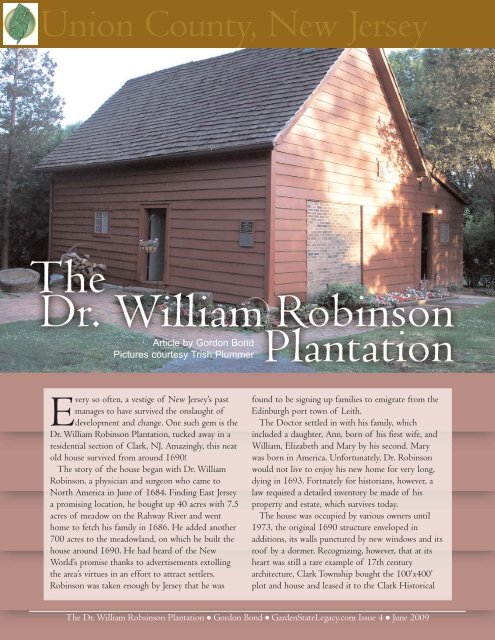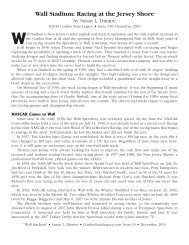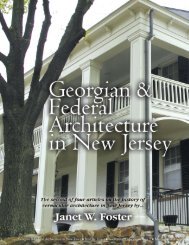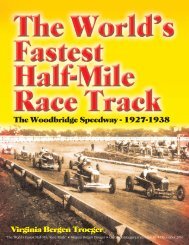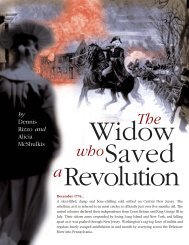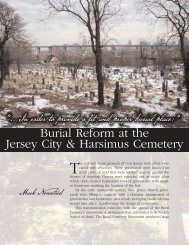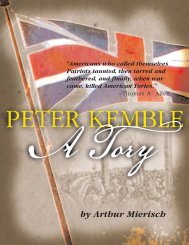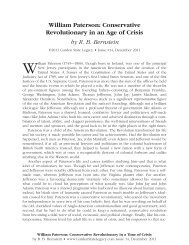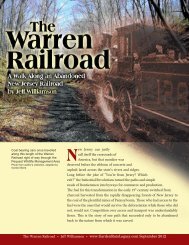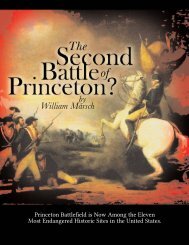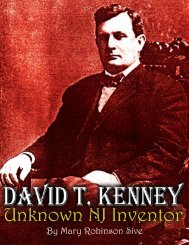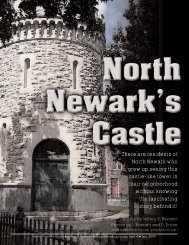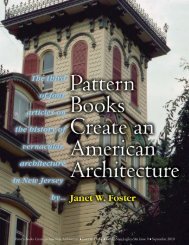The Dr. William Robinson Plantation - Garden State Legacy
The Dr. William Robinson Plantation - Garden State Legacy
The Dr. William Robinson Plantation - Garden State Legacy
Create successful ePaper yourself
Turn your PDF publications into a flip-book with our unique Google optimized e-Paper software.
Union County, New Jersey<br />
Article by Gordon Bond<br />
Pictures courtesy Trish Plummer<br />
Every so often, a vestige of New Jersey’s past<br />
manages to have survived the onslaught of<br />
development and change. One such gem is the<br />
<strong>Dr</strong>. <strong>William</strong> <strong>Robinson</strong> <strong>Plantation</strong>, tucked away in a<br />
residential section of Clark, NJ. Amazingly, this neat<br />
old house survived from around 1690!<br />
<strong>The</strong> story of the house began with <strong>Dr</strong>. <strong>William</strong><br />
<strong>Robinson</strong>, a physician and surgeon who came to<br />
North America in June of 1684. Finding East Jersey<br />
a promising location, he bought up 40 acres with 7.5<br />
acres of meadow on the Rahway River and went<br />
home to fetch his family in 1686. He added another<br />
700 acres to the meadowland, on which he built the<br />
house around 1690. He had heard of the New<br />
World’s promise thanks to advertisements extolling<br />
the area’s virtues in an effort to attract settlers.<br />
<strong>Robinson</strong> was taken enough by Jersey that he was<br />
found to be signing up families to emigrate from the<br />
Edinburgh port town of Leith.<br />
<strong>The</strong> Doctor settled in with his family, which<br />
included a daughter, Ann, born of his first wife, and<br />
<strong>William</strong>, Elizabeth and Mary by his second. Mary<br />
was born in America. Unfortunately, <strong>Dr</strong>. <strong>Robinson</strong><br />
would not live to enjoy his new home for very long,<br />
dying in 1693. Fortnately for historians, however, a<br />
law required a detailed inventory be made of his<br />
property and estate, which survives today.<br />
<strong>The</strong> house was occupied by various owners until<br />
1973, the original 1690 structure enveloped in<br />
additions, its walls punctured by new windows and its<br />
roof by a dormer. Recognizing, however, that at its<br />
heart was still a rare example of 17th century<br />
architecture, Clark Township bought the 100’x400’<br />
plot and house and leased it to the Clark Historical<br />
<strong>The</strong> <strong>Dr</strong>. <strong>William</strong> Robsinson <strong>Plantation</strong> Gordon Bond <strong>Garden</strong><strong>State</strong><strong>Legacy</strong>.com Issue 4 June 2009
Society, who began an extensive restoration. <strong>The</strong>y<br />
stripped away the modern layers to return it to its<br />
original form, including the extra overhang of the<br />
east roof—known as a<br />
“Garrison Overhang,” it was<br />
designed to protect<br />
occupants from arrows or<br />
other missiles if they came<br />
under attack.<br />
Not all the original<br />
elements survived, but care<br />
was taken to reconstruct<br />
them in what was most<br />
likely the same style. <strong>The</strong><br />
fireplace, for example, was<br />
replicated using loose bricks<br />
found on the property and<br />
<strong>The</strong> reconstructed<br />
fireplace.<br />
the mantle came from a<br />
beam in a period barn in<br />
Flemington. <strong>The</strong> house is listed on both the New<br />
Jersey and National Register of Historic Places.<br />
<strong>The</strong> archeological digs conducted around the<br />
house turned up some of the artifacts now on<br />
display, including medicine bottles. <strong>Dr</strong>. <strong>Robinson</strong><br />
would have made use of natural herbs in his<br />
practice. <strong>The</strong> museum staff maintain a modern<br />
herb garden in the back that includes the kinds<br />
of plants that would have been known for<br />
medicinal as well as cooking needs in<br />
<strong>Robinson</strong>’s day.<br />
Out back stands a corn crib, used to store<br />
corn after harvest, along with a barn and<br />
potting shed—home to the resident groundhog!<br />
Also preserved is a pony-drawn milk wagon<br />
from the Sunshine Dairy of Bayonne, NJ.<br />
<strong>The</strong> <strong>Dr</strong>. <strong>William</strong> <strong>Robinson</strong> <strong>Plantation</strong> and<br />
Museum<br />
remains one of<br />
the oldest farm<br />
houses of its<br />
type open to<br />
the public. It is<br />
open every<br />
third Sunday<br />
of the month<br />
from 12:00pm<br />
to 4:00pm, all<br />
year except in<br />
Barn and old milk wagon.<br />
July. Private tours are available by appointment.<br />
<strong>The</strong>re are also a variety of special events. On the<br />
weekend of June 7-6, they hosted a Civil War<br />
encampment as part of their Living History<br />
events series that drew a sizeable crowd (see<br />
pictures here).<br />
It’s wonderful that this unique piece of New<br />
Jersey history has not only survived, but taken on<br />
new life thanks to the hard work of the Clark<br />
Historical Society!<br />
ABOVE: <strong>The</strong> herb garden grows many of the plants<br />
<strong>Dr</strong>. <strong>Robinson</strong> might have used as a physician in the<br />
17th century.<br />
LEFT: Abraham Lincoln greets a vistor to the Civil<br />
War encampment put on as part of the Living History<br />
events hosted by the museum.<br />
<strong>The</strong> <strong>Dr</strong>. <strong>William</strong> Robsinson <strong>Plantation</strong> Gordon Bond <strong>Garden</strong><strong>State</strong><strong>Legacy</strong>.com Issue 4 June 2009


